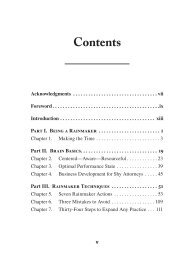(Bk Business) Carol Kinsey Goman Ph.D.-The Nonverbal Advantage_ Secrets and Science of Body Language at Work -Berrett-Koehler Publishers (2008)
Just
Just
You also want an ePaper? Increase the reach of your titles
YUMPU automatically turns print PDFs into web optimized ePapers that Google loves.
150 <strong>The</strong> <strong>Nonverbal</strong> <strong>Advantage</strong><br />
elimin<strong>at</strong>e the discomfort people may feel if the interpersonal<br />
distance is too gre<strong>at</strong> (st<strong>and</strong><strong>of</strong>fish) or too close (intrusive <strong>and</strong><br />
pushy). It might also help you avoid being backed across a<br />
conference room!<br />
Context versus Content Cultures<br />
In context cultures (Mediterranean, Slavic, central European,<br />
L<strong>at</strong>in American, African, Arab, Asian, <strong>and</strong> American Indian),<br />
much <strong>of</strong> the message is left unspecified—to be understood<br />
through the rel<strong>at</strong>ionship <strong>of</strong> the participants, the nonverbal<br />
cues they send, <strong>and</strong> a between-the-lines interpret<strong>at</strong>ion <strong>of</strong><br />
wh<strong>at</strong> is actually said. By contrast, in content cultures (most <strong>of</strong><br />
the Germanic <strong>and</strong> English-speaking countries) messages are<br />
expected to be explicit <strong>and</strong> specific. <strong>The</strong> former are looking<br />
for meaning <strong>and</strong> underst<strong>and</strong>ing in wh<strong>at</strong> is not said—in body<br />
language, in silences <strong>and</strong> pauses, <strong>and</strong> in rel<strong>at</strong>ionships <strong>and</strong><br />
emp<strong>at</strong>hy. <strong>The</strong> l<strong>at</strong>ter place emphasis on sending <strong>and</strong> receiving<br />
accur<strong>at</strong>e messages directly <strong>and</strong> by being precise with spoken<br />
or written words.<br />
People from context cultures tend to view personal bonds<br />
<strong>and</strong> informal agreements as far more binding than any formal<br />
contract. People from content cultures don’t believe the<br />
deal is finalized until everyone has signed on the dotted line.<br />
And therein lies the potential for conflict.<br />
When Lee Iacocca was running Ford Motor Company, he<br />
wanted to buy Ferrari. Some <strong>of</strong> Iacocca’s top people went to<br />
see Enzo Ferrari, <strong>and</strong> they came to an underst<strong>and</strong>ing: Ford<br />
would acquire the production side <strong>of</strong> Ferrari. <strong>The</strong> deal was<br />
made on a h<strong>and</strong>shake. Soon, though, Ford’s <strong>at</strong>torneys arrived<br />
in Italy with contracts, <strong>and</strong> an accounting crew arrived to<br />
take inventory. This was normal business procedure for the<br />
Americans, but Ferrari was insulted. After all, he had an<br />
underst<strong>and</strong>ing with a gentleman, not with a group <strong>of</strong> <strong>at</strong>torneys<br />
<strong>and</strong> accountants! <strong>The</strong> deal fell through.




